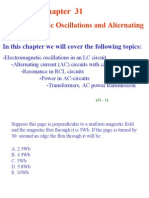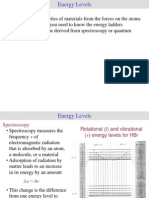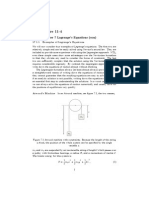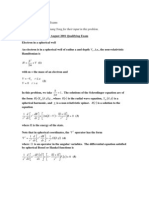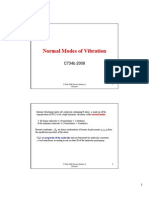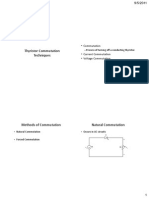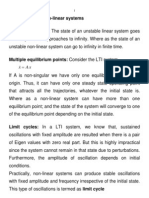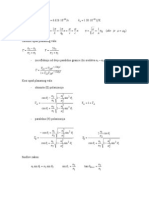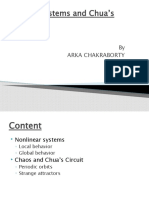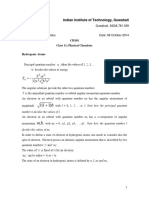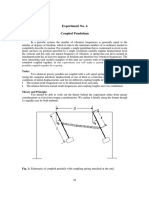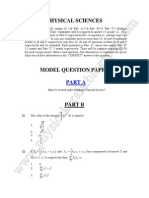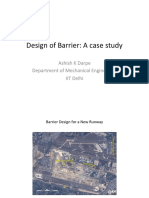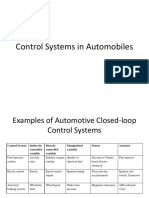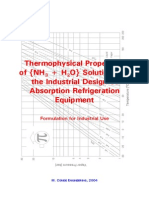Particle Moving On A Circle: The Two-Dimensional Rotor: CYL110/Chakravarty
Particle Moving On A Circle: The Two-Dimensional Rotor: CYL110/Chakravarty
Uploaded by
zeeshanahmad111Copyright:
Available Formats
Particle Moving On A Circle: The Two-Dimensional Rotor: CYL110/Chakravarty
Particle Moving On A Circle: The Two-Dimensional Rotor: CYL110/Chakravarty
Uploaded by
zeeshanahmad111Original Description:
Original Title
Copyright
Available Formats
Share this document
Did you find this document useful?
Is this content inappropriate?
Copyright:
Available Formats
Particle Moving On A Circle: The Two-Dimensional Rotor: CYL110/Chakravarty
Particle Moving On A Circle: The Two-Dimensional Rotor: CYL110/Chakravarty
Uploaded by
zeeshanahmad111Copyright:
Available Formats
CYL110/Chakravarty
Particle Moving on a Circle:
The Two-dimensional Rotor
CYL110/Chakravarty
CYL110/Chakravarty
The Classical Picture
Model for understanding rotational
motion
Particle restricted to move on a circle
of radius a with moment of inertia
I=ma
2
Particle only has rotational kinetic
energy from rotation about z-axis
which is greater than or equal to zero
Will move with uniform speed v along
the circle; therefore, probability of
finding the particle anywhere on the
circle is equal
I
L
ma
L
E
z
2 2
2
2
2
= =
x-axis
y-axis
r
|
|
|
sin
cos
s Coordinate Polar Circular
r y
r x
=
=
I
L
ma
L
E
z
2 2
2
2
= =
CYL110/Chakravarty
Solving Schrodingers Equation
Require an operator representation of L
z
2
operator:
E
d
d
ma
=
2
2
2
2
2
Schrodingers equation can then be written as:
2
2
2
2
2 2
2
ma
L
H
L
i x
y
y
x
i
L
z
z
z
=
c
c
=
c
c
=
|
|
.
|
\
|
c
c
c
c
=
CYL110/Chakravarty
Criteria for choosing the specific solutions:
1. Probability along the circle must be uniform, given that
rotation by any angle | leaves the system unchanged
Can you justify this on the basis of symmetry?
2. The eigenfunctions of the Hamiltonian must also be
eigenfunctions of the L
z
operator.
Which postulate does this refer to?
) exp( ) ( ik A =
Mathematically allowed general solutions:
x) cos( ) exp(
x) cos( ) sin(
/ 2
ik B ikx A
k B kx A
mE k
+ =
+ =
=
CYL110/Chakravarty
Circular Boundary Conditions lead to integer quantum numbers
and discrete energy levels. Note that these periodic boundary
conditions are equivalent to requiring that the wavefunction
must be single-valued.
,.... 2 , 1 , 0
2
/ 2
) ( ) 2 (
2
2 2
2
=
=
= =
= +
n
ma
n
E
n E ma k
t
Normalization condition
t
t
2 / 1 1 ) (
2
2
0
= =
}
A d
CYL110/Chakravarty
Connection with the de Broglie
equation
2
2 2
2
2 2
ma
n
E
mE
h
mK
h
p
h
n
=
= = =
L n t 2 =
Think of fitting an integer number of wavelengths in along a circle of
radius a so that there is no phase mismatch
Since potential energy inside the box is zero, we can write:
In this case we did not need to solve the Schrodinger equation because
the potential energy was constant in the region where the probability of
finding the particle was non-zero. The de Broglie equation does not tell
us anything about degeneracy.
CYL110/Chakravarty
Energy Levels & Wavefunctions
Each energy level and wavefunction is labeled by a quantum
number n=0,+/-1,+/-2,+/-3,
The particle has no zero-point energy. The absence of zero-point
energy can be understood on the basis of the uncertainty principle.
The angular variable | is allowed to have any value between 0 and
2t with equal probability.
Therefore uncertainity in position is maximum.
Except for the ground state, all other levels are doubly degenerate.
The two values of ncorrespond to angular momentum vectors
which are equal in magnitude but parallel or antiparallel relative to
the z-axis.
Find the eigenvalue and uncertainty associated with the
L
z
operator.
No nodes for the wavefunctions
Show that the set of wavefunctions of a particle moving on a ring
forms an orthonormal set
You might also like
- Goldstein 18 21 13 14 20Document15 pagesGoldstein 18 21 13 14 20Abdul Shakoor ButtNo ratings yet
- Acoustics Wave EquationsDocument27 pagesAcoustics Wave Equationszeeshanahmad111No ratings yet
- UNIT LEARNING PLAN I (General Physics 1) SDocument3 pagesUNIT LEARNING PLAN I (General Physics 1) SMatt Jordene VisperasNo ratings yet
- 1.electrical Charges and FieldsDocument45 pages1.electrical Charges and FieldsOnetap solutionsNo ratings yet
- Selection Rules and Transition Moment IntegralDocument11 pagesSelection Rules and Transition Moment IntegralRashid AliNo ratings yet
- Selection Rules and Transition Moment IntegralDocument11 pagesSelection Rules and Transition Moment IntegralMawar ShantikaNo ratings yet
- Gen Chem-Lect 9-02-09-24Document33 pagesGen Chem-Lect 9-02-09-24korasikha27No ratings yet
- Particle in A 1d Box Quantum MechanicsDocument22 pagesParticle in A 1d Box Quantum Mechanicsvivek patel0% (1)
- Chemistry 101 - SEAS Quantization Alá Schrödinger: A Summary of Some Exactly Soluble SystemsDocument3 pagesChemistry 101 - SEAS Quantization Alá Schrödinger: A Summary of Some Exactly Soluble Systemsjesi5445No ratings yet
- Hydrogen Atom in Wave MechanicsDocument14 pagesHydrogen Atom in Wave MechanicsSaleemNo ratings yet
- Electromagnetic Oscillations and Alternating Current: in This Chapter We Will Cover The Following TopicsDocument31 pagesElectromagnetic Oscillations and Alternating Current: in This Chapter We Will Cover The Following Topicsnadir9999No ratings yet
- CH 11Document39 pagesCH 11Gido LeiNo ratings yet
- Physical Chemistry Study GuideDocument9 pagesPhysical Chemistry Study Guidekrymxen100% (2)
- Physics 9C Midterm 2 SolutionsDocument7 pagesPhysics 9C Midterm 2 SolutionsTiffany LeeNo ratings yet
- 17 Lecture 11-4: 17.1 Chapter 7 Lagrange's Equations (Con)Document9 pages17 Lecture 11-4: 17.1 Chapter 7 Lagrange's Equations (Con)Ty WilliamsNo ratings yet
- Thanks To Yossef and Shiang Yong For Their Input in This ProblemDocument8 pagesThanks To Yossef and Shiang Yong For Their Input in This ProblemIgnacio JuárezNo ratings yet
- Physics Quiz 2Document7 pagesPhysics Quiz 2Edgar ContrerasNo ratings yet
- Linear AlgebraDocument13 pagesLinear AlgebrakhairunnisalazimNo ratings yet
- Quantum Mechanics Tunneling & Harmonic OscillatorDocument33 pagesQuantum Mechanics Tunneling & Harmonic Oscillatorvivek patelNo ratings yet
- 3.5 y 3.6Document6 pages3.5 y 3.6Flor Hernandez TiscareñoNo ratings yet
- Ch4 Virtual BookDocument23 pagesCh4 Virtual BookAbcNo ratings yet
- Part One Waveguides and CavitiesDocument9 pagesPart One Waveguides and CavitiesnananghadisodikinNo ratings yet
- Introduction To Resonant CircuitsDocument31 pagesIntroduction To Resonant Circuitshodeegits9526No ratings yet
- Group Theory-Part 10 Normal Modes of VibrationDocument10 pagesGroup Theory-Part 10 Normal Modes of VibrationRD's AcademyNo ratings yet
- Lecture17 05052023Document73 pagesLecture17 05052023gianfrancogiannoni4No ratings yet
- Rotational Motion: Rotation in Two Dimensions: A Particle On A RingDocument41 pagesRotational Motion: Rotation in Two Dimensions: A Particle On A RingAdelia Ayu WandiraNo ratings yet
- Lattice Vibrations, Part I: Solid State Physics 355Document22 pagesLattice Vibrations, Part I: Solid State Physics 355Rheza Al BlitariyNo ratings yet
- Rydberg's Spectrum AnalysisDocument50 pagesRydberg's Spectrum AnalysisUday Prakash SahuNo ratings yet
- Interaction of Light and Matter: 8.1 Electromagnetic Waves at An InterfaceDocument34 pagesInteraction of Light and Matter: 8.1 Electromagnetic Waves at An InterfaceWilson Aponte HuamantincoNo ratings yet
- Exp1 Prelab2 Farid Mammadov 25.09.2024Document19 pagesExp1 Prelab2 Farid Mammadov 25.09.2024faridcappuccino1501No ratings yet
- 2011 RF OscillatorDocument27 pages2011 RF OscillatordjordjesivcevNo ratings yet
- Unit 4 Band Theory of SolidsDocument25 pagesUnit 4 Band Theory of SolidsAshema AggarwalNo ratings yet
- Sem221 - Chem311 - Chapter15 and 16.3Document36 pagesSem221 - Chem311 - Chapter15 and 16.3hussainNo ratings yet
- Lecture 5-2Document16 pagesLecture 5-2Chetan Gupta GuptaNo ratings yet
- HF Cacelli RevisedDocument21 pagesHF Cacelli RevisedAmira MohamedNo ratings yet
- Quantum Model of The Hydrogen Atom - Clase Martes - 15!10!2013Document44 pagesQuantum Model of The Hydrogen Atom - Clase Martes - 15!10!2013cperezScribdNo ratings yet
- Atomic SpectrosDocument36 pagesAtomic SpectrosAswin AlexNo ratings yet
- Chapter 1Document142 pagesChapter 1Cuong Hoang VietNo ratings yet
- Lecture 5-2Document22 pagesLecture 5-2ktekk5105No ratings yet
- Solution 03Document11 pagesSolution 03ssstelNo ratings yet
- Thyristor Commutation Techniques NewDocument8 pagesThyristor Commutation Techniques NewChristine de SagunNo ratings yet
- Second Order TransientsDocument6 pagesSecond Order Transientsmusy1233No ratings yet
- Behaviour of Nonlinear SystemsDocument11 pagesBehaviour of Nonlinear SystemsCheenu SinghNo ratings yet
- Example Problem: SolutionDocument26 pagesExample Problem: SolutionRay TakazaNo ratings yet
- TOK Equations1Document3 pagesTOK Equations1Majid HajricNo ratings yet
- CHEMF111 Lecture5 Aug12 2016 - BPHCDocument23 pagesCHEMF111 Lecture5 Aug12 2016 - BPHCAshish GuptaNo ratings yet
- Chaotic Systems and Chua's CircuitDocument17 pagesChaotic Systems and Chua's CircuitArka ChakrabortyNo ratings yet
- ChapterDocument26 pagesChapterdvdmega0% (1)
- Lecture 10 - Ch16 - Dynamics of Bloch Electrons PDFDocument39 pagesLecture 10 - Ch16 - Dynamics of Bloch Electrons PDFmigueladmNo ratings yet
- Chapter 21-Electric Charge and Electric FieldsDocument28 pagesChapter 21-Electric Charge and Electric Fieldsdog171173No ratings yet
- Indian Institute of Technology, Guwahati: CH101 Class 11 Physical ChemistryDocument5 pagesIndian Institute of Technology, Guwahati: CH101 Class 11 Physical ChemistryMihir Kumar MechNo ratings yet
- An Introduction To Relativistic Quantum Chemistry - Lucas VisscherDocument111 pagesAn Introduction To Relativistic Quantum Chemistry - Lucas Visscherandrew1553No ratings yet
- Atomic StructureDocument28 pagesAtomic StructurePavan GoudNo ratings yet
- Ch37 Young Freedman4Document26 pagesCh37 Young Freedman4Andrew MerrillNo ratings yet
- Beam Element ExampleDocument4 pagesBeam Element ExampleAzim SamiinNo ratings yet
- Coupled PendulumDocument6 pagesCoupled Pendulumsachin bhadangNo ratings yet
- 01 HydrogenicDocument19 pages01 HydrogenicManiz PuusNo ratings yet
- Schroedinger Equation Atomic Wave Functions Atomic Orbitals Quantum NumbersDocument45 pagesSchroedinger Equation Atomic Wave Functions Atomic Orbitals Quantum NumbersRishit JakhariaNo ratings yet
- Ugc Csir Net Physics 2011 June ModelDocument15 pagesUgc Csir Net Physics 2011 June ModelBhargav AlavaniNo ratings yet
- Feynman Lectures Simplified 2C: Electromagnetism: in Relativity & in Dense MatterFrom EverandFeynman Lectures Simplified 2C: Electromagnetism: in Relativity & in Dense MatterNo ratings yet
- Initial Investment $2,000,000.00 Year Cash Flow 1 $1,000,000 2 $1,000,000 3 $1,000,000Document3 pagesInitial Investment $2,000,000.00 Year Cash Flow 1 $1,000,000 2 $1,000,000 3 $1,000,000zeeshanahmad111No ratings yet
- Practice Problems Based On Free & Forced Vibrations of SDOF SystemDocument3 pagesPractice Problems Based On Free & Forced Vibrations of SDOF Systemzeeshanahmad111100% (1)
- Sound Energy DensityDocument5 pagesSound Energy Densityzeeshanahmad111No ratings yet
- Design of Barrier: A Case StudyDocument15 pagesDesign of Barrier: A Case Studyzeeshanahmad111No ratings yet
- Caste System in IndiaDocument13 pagesCaste System in Indiazeeshanahmad1110% (1)
- MufflerElementAnalysis2014 ConciseDocument21 pagesMufflerElementAnalysis2014 Concisezeeshanahmad111No ratings yet
- Library Book ListDocument24 pagesLibrary Book Listzeeshanahmad111No ratings yet
- List of Online Journals SDocument8 pagesList of Online Journals Szeeshanahmad111No ratings yet
- Dowry System in IndiaDocument4 pagesDowry System in Indiazeeshanahmad111No ratings yet
- Time Table For ExamDocument5 pagesTime Table For Examzeeshanahmad111No ratings yet
- Solutions Stoeker JonesDocument14 pagesSolutions Stoeker Joneszeeshanahmad111No ratings yet
- Indian Economy On The Eve of IndependenceDocument37 pagesIndian Economy On The Eve of Independencezeeshanahmad11167% (3)
- Lighting FundamentalsDocument43 pagesLighting Fundamentalszeeshanahmad111No ratings yet
- INCONTROL Simulation Solutions ED9 S ENGDocument2 pagesINCONTROL Simulation Solutions ED9 S ENGzeeshanahmad111No ratings yet
- Propagation of Highly Nonlinear Solitary Waves in A Curved Granular ChainDocument10 pagesPropagation of Highly Nonlinear Solitary Waves in A Curved Granular Chainzeeshanahmad111No ratings yet
- Stacking Sequence Optimization With Genetic Algorithm Using A Two-Level ApproximationDocument11 pagesStacking Sequence Optimization With Genetic Algorithm Using A Two-Level Approximationzeeshanahmad111No ratings yet
- Boundary Layer NotesDocument17 pagesBoundary Layer NotesgarystevensozNo ratings yet
- The Car Transmission BibleDocument12 pagesThe Car Transmission Biblezeeshanahmad111100% (1)
- Free Convection: Its Free, No Operating Cost! .. Its Natural .Document34 pagesFree Convection: Its Free, No Operating Cost! .. Its Natural .zeeshanahmad111No ratings yet
- Control Systems in Automobile PDFDocument36 pagesControl Systems in Automobile PDFVinoth MalaikaniNo ratings yet
- Traction Control SystemDocument4 pagesTraction Control Systemzeeshanahmad111100% (1)
- Aqua Ammonia PropertiesDocument0 pagesAqua Ammonia Propertieszeeshanahmad111No ratings yet
- MMW Module 2 WGN 4Document5 pagesMMW Module 2 WGN 4Banana 214No ratings yet
- Business Statistics: A First Course: 6 EditionDocument10 pagesBusiness Statistics: A First Course: 6 EditionPeterNo ratings yet
- Klein Limit Hbar To Zero Quantum Theory AjpDocument9 pagesKlein Limit Hbar To Zero Quantum Theory AjpUlf KleinNo ratings yet
- Chi Square Using NIPS CandyDocument3 pagesChi Square Using NIPS CandyLoo Siaw ChoonNo ratings yet
- Inferential StatsDocument11 pagesInferential Statsvisu009No ratings yet
- Reviewer PRDocument4 pagesReviewer PRaaronjamesllavore2No ratings yet
- A Brief Introduction Into Quantum Gravity and Quantum CosmologyDocument77 pagesA Brief Introduction Into Quantum Gravity and Quantum CosmologyDiluNo ratings yet
- AnalysisDocument2 pagesAnalysishi034466No ratings yet
- GravitymodelDocument1 pageGravitymodelapi-314084641No ratings yet
- Practical ReportingDocument14 pagesPractical Reportingdammyakapo01No ratings yet
- Relativistic Quantum Mechanics: Andreas BrandhuberDocument75 pagesRelativistic Quantum Mechanics: Andreas BrandhuberEhtishamNo ratings yet
- MIT8 04S16 LecNotes14 15Document9 pagesMIT8 04S16 LecNotes14 15JefersonNo ratings yet
- Grounded Theory: Sonoma State University, USA, and University of Miami, USADocument6 pagesGrounded Theory: Sonoma State University, USA, and University of Miami, USAthanhtuan.to1993No ratings yet
- Chi-Square Test: Milan A JoshiDocument39 pagesChi-Square Test: Milan A JoshiUmang ShahNo ratings yet
- Introduction To ResearchDocument34 pagesIntroduction To Researchshehan pramodyaNo ratings yet
- Intro QM DiracDocument17 pagesIntro QM DiracViwek MertiyaNo ratings yet
- Chapter 1Document11 pagesChapter 1sintayehugonfa988No ratings yet
- Hypothesis Testing and Different Types of Test To Use in Hypothesis TestingDocument3 pagesHypothesis Testing and Different Types of Test To Use in Hypothesis TestingAlyanna Elisse VergaraNo ratings yet
- Tut-sheet-2-PHL120-13 With Final Answers PDFDocument2 pagesTut-sheet-2-PHL120-13 With Final Answers PDFjgrgpt33No ratings yet
- QMLN 01 Schrödinger EquationDocument10 pagesQMLN 01 Schrödinger EquationAnum Hosen ShawonNo ratings yet
- Introduction To Chi-Square: O Is The Observed Frequency, and E Is The Expected FrequencyDocument8 pagesIntroduction To Chi-Square: O Is The Observed Frequency, and E Is The Expected FrequencyNutukurthi Venkat RamjiNo ratings yet
- G11 Statistics and Probability Q3 M1Document10 pagesG11 Statistics and Probability Q3 M1Queen Alexza PrandasNo ratings yet
- String Theory Vs Loop Quantum GravityDocument9 pagesString Theory Vs Loop Quantum Gravityapi-241908559No ratings yet
- Hypothesis TestingDocument80 pagesHypothesis TestingM. JaddouaNo ratings yet
- Chapter 004Document7 pagesChapter 004Laura MinorNo ratings yet
- Theoretical and Conceptual FrameworkDocument56 pagesTheoretical and Conceptual FrameworkbryannjujsNo ratings yet
- 20ma402 Ps Unit III DCMDocument77 pages20ma402 Ps Unit III DCMKeshavardhan D.RNo ratings yet
- QM Session 4Document44 pagesQM Session 4harherron123No ratings yet
- Dream Minecraft ReportDocument19 pagesDream Minecraft ReportAiden LimNo ratings yet










